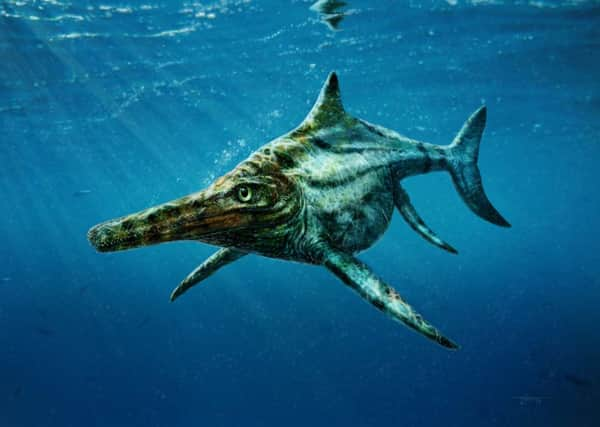Bones of ‘Nessie’s cousin’ found on Isle of Skye


But bones of a fearsome prehistoric sea creature found 100 miles from Loch Ness have now been identified as an important new species that could shed light on the time when dinosaurs roamed the earth.
Palaeontologists examining fossilised remains found on the Isle of Skye said they belong to a previously undiscovered ichthyosaur, a large dolphin-like marine reptile that could grow to more than four metres in length.
Advertisement
Hide AdAdvertisement
Hide AdThe giant meat-eating predator would have swum in the warm, shallow seas around what is now “the Misty Isle” about 170 million years ago during the early to middle Jurassic era.
With its long, tooth-lined snout, the sea monster would have been near the top of the food chain, dining on other reptiles and fish.
Experts have named the new species Dearcmhara shawcrossi, making it one of the few to have ever been given a Gaelic name.
Ichthyosaur comes from the Greek for fish lizard. Dearcmhara – pronounced “jarkvara” - means lizard of the sea in Gaelic and pays homage to the history of Skye and the Hebrides.
Shawcrossi honours amateur fossil-hunter Brian Shawcross, who unearthed the ancient bones at the island’s Bearreraig Bay.
Skye is one of the few places in the world where fossils from the middle Jurassic period can be found and the research team said discoveries there could provide valuable insights into how marine reptiles evolved.
Study leader Dr Steve Brusatte, of the University of Edinburgh’s School of GeoSciences, said: “During the time of dinosaurs the waters of Scotland were prowled by big reptiles the size of motorboats.
“Their fossils are very rare, and only now for the first time we have found a new species that was uniquely Scottish.”
Much of Skye was submerged during the Jurassic period.
Advertisement
Hide AdAdvertisement
Hide AdIt was joined to the rest of the UK and part of a large island positioned between landmasses that gradually drifted apart to became Europe and North America.
The island is the “epicentre” of Scotland’s fossil trove, according to Dr Brusatte.
He said: “All of Scotland’s dinosaurs come from Skye, as well as most of the fossils of these ocean-living reptiles.
“Skye is really important globally because the fossils there are from the middle part of the Jurassic period, about 160 to 180 million years ago, and that is one of the worst-known intervals for reptiles and dinosaurs of their entire history.
“We have hardly any fossils of middle-Jurassic dinosaurs from anywhere in the world. It is a dark period. But some of the best are right here in Scotland.”
He added: “We are honoured to name the new species after Mr Shawcross and will do the same if any other collectors wish to donate new specimens.”